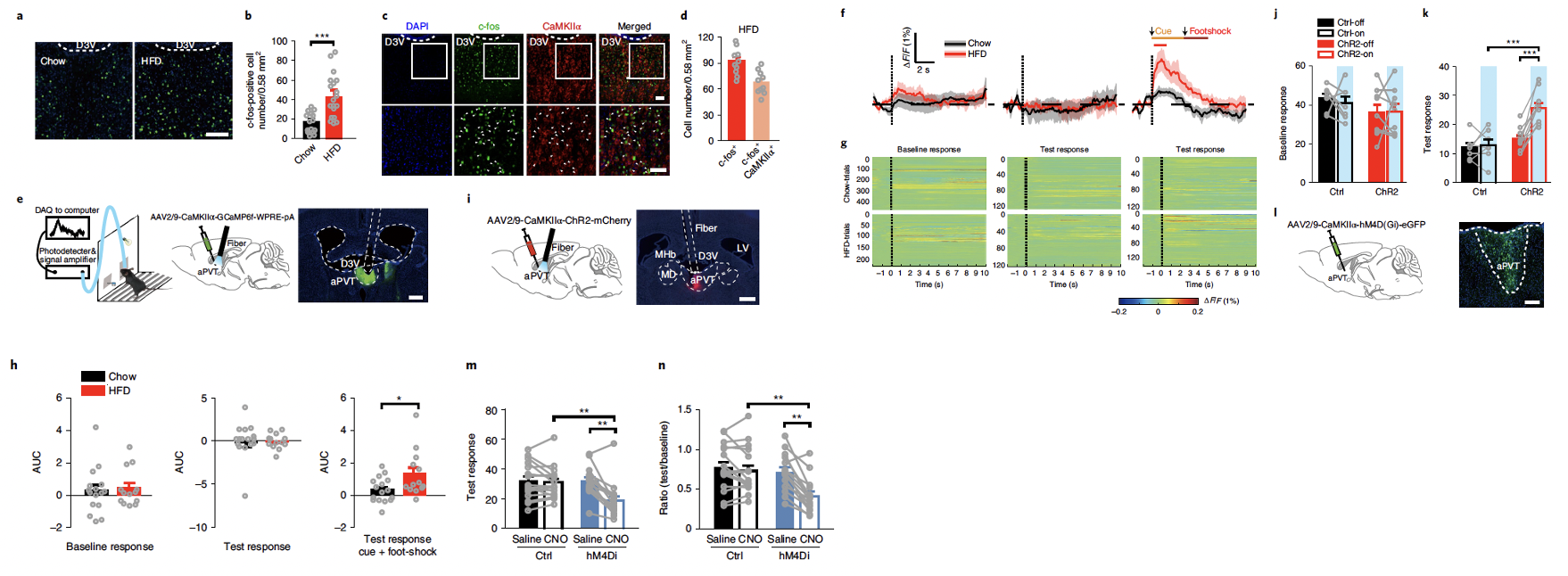- E-mail:BD@ebraincase.com
- Tel:+8618971215294
When animals encounter life-threatening situations, they often resort to compulsive behaviors to sustain their survival. For instance, research has reported that high-fat diet (HFD) consumption impedes threat-cue-induced suppression of sucrose-seeking in mice. The study found that HFD activates microglia, triggering neuronal activity in the anterior paraventricular thalamus (aPVT), which leads to a series of metabolic inflammatory responses and results in compulsive food-seeking behavior.
Using c-fos immunohistochemistry, researchers compared neuronal activation patterns in various brain areas/nuclei of HFD mice and chow-fed mice (control) after the compulsive sucrose-seeking test. One of the brain areas that showed large differences in the number of c-fos-positive (c-fos+) cells between HFD mice and chow mice was the aPVT, which is known to play a role in the regulation of food-seeking. More than 70% of the c-fos+ cells in the aPVT were also positive for CaMKIIα.
To further examine how aPVT neurons respond in different aspects of compulsive eating behavior, researchers used fiber photometry to record Ca2+ transients in CaMKIIα+ neurons of the aPVT in mice during the compulsive sucrose-seeking paradigm. When lever presses were followed by a cue light, the light in HFD mice triggered a larger Ca2+ transient in the aPVT than in chow-fed mice (Fig. 1f–h, right). The increase in Ca2+ transients in the aPVT was consistent with the increased number of c-fos+ cells in this region in HFD mice. This result suggests that the HFD-induced increase in c-fos+ neuronal activation in the aPVT may underlie compulsive eating behavior.
Next, researchers used optogenetic activation of glutamatergic neurons in the aPVT and found that photo stimulation significantly increased the number of lever presses in HFD mice, but not in control chow mice (Fig. 1k). This result indicates that activating aPVT CaMKIIα+ neurons is sufficient to drive compulsive sucrose-seeking behavior in mice.
Conversely, researchers used clozapine-N-oxide (CNO) to inhibit aPVT excitatory neurons expressing hM4Di-eGFP in fear-conditioned HFD mice performing the operant task. The results showed that CNO administration reduced the firing frequency of neurons expressing hM4Di and decreased the number of lever presses in HFD mice expressing hM4Di-eGFP, but not in control HFD mice expressing eGFP, when these mice were presented with the light cue (Fig. 1m). This led to a lower ratio of lever presses in the test session to lever presses in the baseline session (Fig. 1n). These results indicate that chemogenetic inhibition of aPVT CaMKIIα+ neurons reduces compulsive sucrose-seeking in fear-conditioned HFD mice.
Overall, the activity level of excitatory neurons in the aPVT determines the motivation to obtain a food reward in the presence of a cue predicting an aversive stimulus.

Fig1. Investigating the responses of neurons in the aPVT nucleus to different aspects of compulsive eating behavior in chow mice and HFD mice.(more details https://www.nature.com/articles/s41593-022-01129-y)
The aPVT, as a nucleus of the midline thalamus, may contain sentinel cells that detect metabolic factors in the cerebrospinal fluid (CSF). Researchers indeed found that HFD significantly increased the number of Iba-1+ microglia in the aPVT (Fig. 2a, b), and c-fos+ CaMKIIα neurons were close to and had a large contact area with Iba-1+ microglia in the aPVT. Using the colony-stimulating factor 1 receptor antagonist PLX3397 (which depletes microglia) inhibited neuronal activation in the aPVT of HFD mice (Extended Data) and eliminated compulsive sucrose-seeking behavior in these mice (Fig. 2c, d). Additionally, local injection of a CSF-1 antibody (which specifically reduces microglia in the aPVT, Fig. 2f, g) significantly reduced the number of c-fos+ neurons in the aPVT of HFD mice and their contact with Iba-1+ microglia. Depleting a portion of the microglia in the aPVT also eliminated compulsive sucrose-seeking behavior in HFD mice (Fig. 2h, i) without altering their freezing behavior and pain sensitivity (Extended Data). These results indicate that HFD-induced microglial proliferation in the aPVT causes compulsive eating behavior in HFD mice.

Fig2. HFD induces microglial proliferation in the aPVT and increases their contact area with c-fos+ CaMKIIα neurons, triggering compulsive eating behavior in mice
For more details, please refer to the original article at https://www.nature.com/articles/s41593-022-01129-y
Catalog Number. BC-SL014
Product Name. AAV-CaMKIIα-FCSSP-EYFP-5E4 (Sparse labeling virus for CaMKIIα+ cells)
Fig3. The product used in the study to assess whether the local injection of CSF-1 antibody causes neuronal damage. This product can sparsely and brightly label the morphology and structure of neurons, and in some scenarios, it can replace the Golgi staining method.
Click to fill in the requirements and submit them to us!